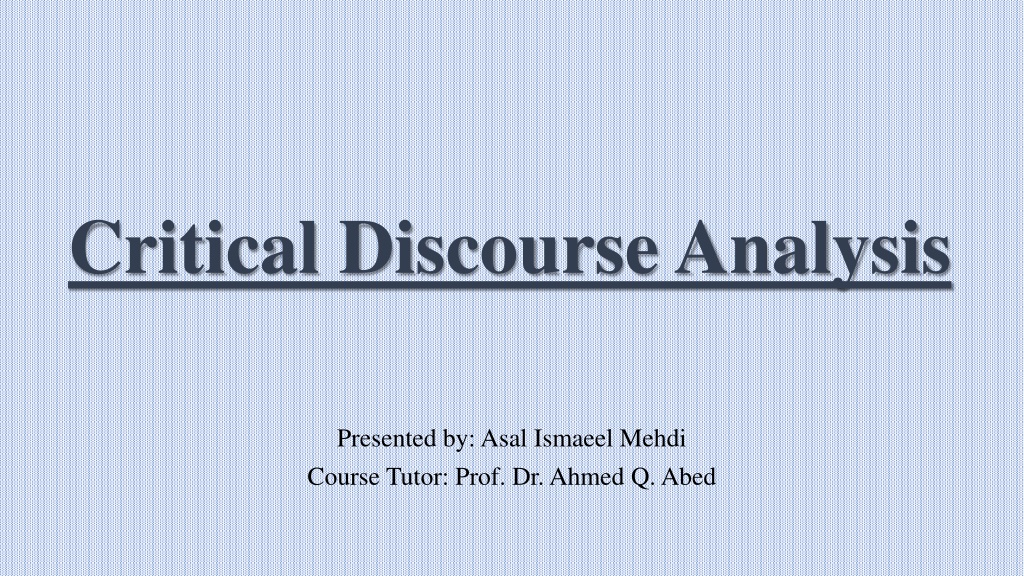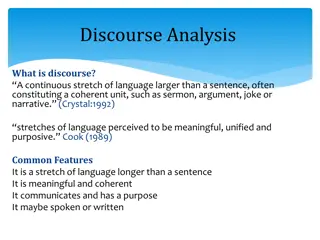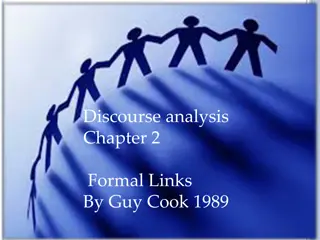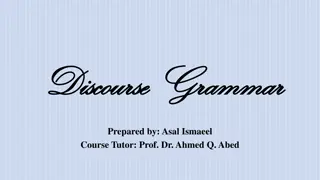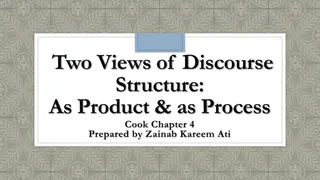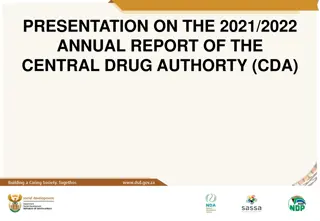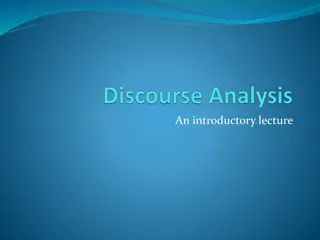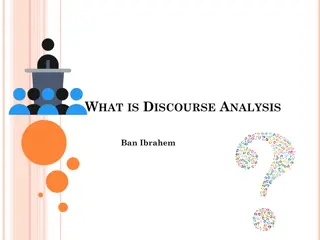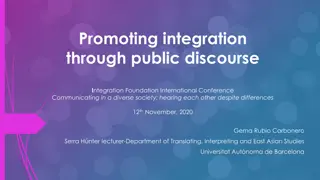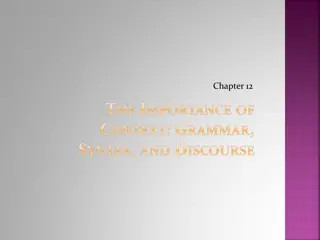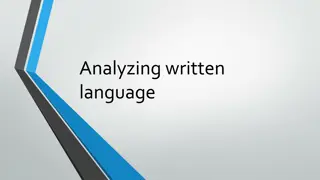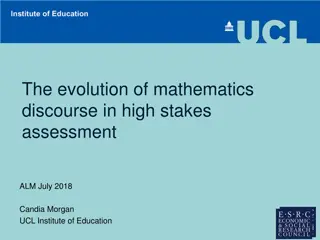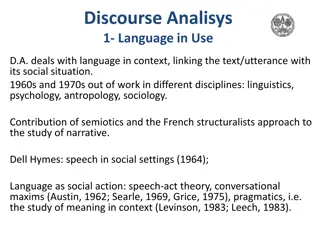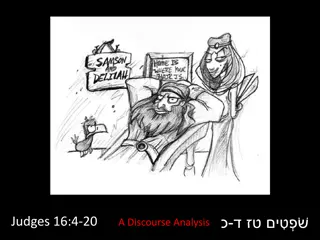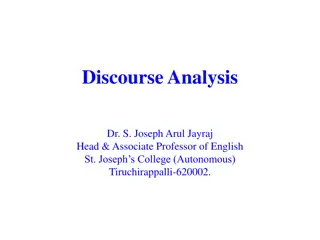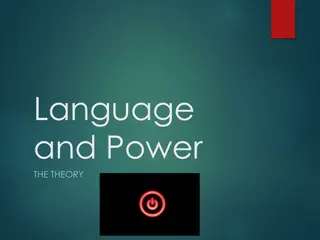Introduction to Critical Discourse Analysis (CDA)
Critical Discourse Analysis (CDA) is the study of language use in social contexts, integrating social theories with discourse analysis methods. Originating in the 1970s as Critical Linguistics (CL), CDA evolved to focus on how language reflects and shapes social meaning. The relationship between CL and CDA is intertwined, with both drawing upon key thinkers like Benjamin Lee Whorf and Michael Halliday. The Sapir-Whorf hypothesis posits that language influences thought, emphasizing the need for approaches like Halliday's Systemic Functional Linguistics. Halliday's theory identifies ideational, interpersonal, and textual functions of language, highlighting the role of language in communicating ideas and values in different social contexts.
Download Presentation

Please find below an Image/Link to download the presentation.
The content on the website is provided AS IS for your information and personal use only. It may not be sold, licensed, or shared on other websites without obtaining consent from the author.If you encounter any issues during the download, it is possible that the publisher has removed the file from their server.
You are allowed to download the files provided on this website for personal or commercial use, subject to the condition that they are used lawfully. All files are the property of their respective owners.
The content on the website is provided AS IS for your information and personal use only. It may not be sold, licensed, or shared on other websites without obtaining consent from the author.
E N D
Presentation Transcript
Critical Discourse Analysis Presented by: Asal Ismaeel Mehdi Course Tutor: Prof. Dr. Ahmed Q. Abed
What is CDA? Define CDA. CDA: is simply the study of discourse in its social context, it attempts to combine a social theory of discourse with theories and methods of discourse analysis. That is, a social theory of discourse means that language use is a social practice that can both reflect and constitute social meanings.
The Beginning of CDA The beginning of Critical Discourse Analysis: - In the 1970s a group of linguists in West Anglea University who developed the approach to discourse analysis called Critical Linguistics (CL) which was further developed into Critical Discourse Analysis (CDA) in 1989 and the early 1990s by the intensive productions of a number of discourse analysts like: Van Dijk, Fairclough, Kress, and Wodak. Critical Discourse Analysis (CDA) Developed to be Critical Linguistics (CL)
The Relationship between CL& CDA According to KhosraviNik, CDA has benefited from CL and its techniques in analysing discourses The two terms CDA and CL have been used interchangeably in many studies. Machin & Mayr justified that by saying that both CDA and CL draw on two principal thinkers: The American linguist Benjamin Lee Whorf & The British linguist Michael Halliday
The Sapir-Whorf hypothesis The Sapir-Whorf hypothesis in its two strong and weak versions, that are: linguistic determinism and linguistic relativity proposes that: language determines thinking and the native language influences one s thought and perception . It is similar to Fowler s statement: differences of linguistic structure cause the speakers of different languages in some sense to see the world in different ways . So, the need for CL and Halliday s Systemic Functional Linguistics appeared since Halliday s functional model of language examines the connection between: Linguistic Structure and Social Values.
Ideational, Interpersonal and Textual Functions Halliday s main premises are that linguistic forms are systematically affected by the social circumstances, language communicates ideas, processes and entities by serving: three major functions: 1. The ideational function of language serves to represent events, processes and participants. 2. The interpersonal function serves to express the speaker s attitudes towards the events and the participants represented. 3. The textual function of language serves to present these ideas and events in coherent texts, or in other words, it is the process of creating a text.
It is through the interrelation of these functions that: ideologies, political views and relations of power are revealed in New Discourse (ND) and drawing on Halliday s functional model of language, Critical Discourse Analysis studies language as: "a form of social practice determined by social structure"
CDA approach Linguistically Oriented Socially Oriented Discursive practices Socio-cultural practices
Socially- Oriented Discursive practices Socio-cultural practices Include action and interaction, social relations, the material world, material practices the rituals, beliefs, attitudes, values, desires of people and institutions. Also include "power and discourse, forms of consciousness, time and space, objects, instruments, subjects and their social relations and activities as well as abstract social structures, concrete social events. refer to the wider range of socio-cultural, political, ideological and institutional processes and structures in historical contexts.
Linguistically- Oriented Non-critical approaches are linguistically-oriented or simply descriptive. They merely describe the discursive events. Critical approaches: describe the discursive events and, also reflect ideologies and relations of power through discourse. To Van Dijk, CDA is not a mere analysis or description of the formal features of discourse in a language but, rather, it investigates the role of language in social contexts and the relations of power and hegemony in society . And concepts such as discourse , ideology and power are of major interest to CD analysts
Levels of CDA 1. The description level is interested in the formal properties of texts. 2. The interpretation level studies the interaction between the text and the discursive practices through "processes of text production, distribution and consumption . 3. The explanation level is concerned with the relation between discourse and its social context. Ideologies and relations of power in news discourse are mainly investigated in the interpretation stage of CDA. Van Dijk said that power relations and ideologies have a pervasive impact or role upon discourse interpretation and production, for they are embedded in the interpretative procedures the social orders which underlie the highest level of interpretative decisions on which others are dependent what situation am I in? .
Principles of CDA CDA is "an explicitly political approach to discourse CD analysts like Fairclough & Fairclough, adopt Van Dijk s interchangeable use of CDA with political discourse analysis. A CD analyst is a discourse analyst with "a clear stance, and an established worldview Van Dijk contrasts CD analyst with analysts of other approaches as follows: Unlike other discourse analysts, critical discourse analysts (should) take an explicit socio-political stance: they spell out their point of view, perspective, principles and aims, both within their discipline and within society at large. Although not in each stage of theory formation and analysis, their work is admittedly and ultimately political .
Machin & Mayr stated that, it is "this hierarchical power struggle and social inequality that CD analysts set out to unmask". Such perspective is very evident in Fairclough s definition of CDA as follows: relationships of causality and determination between (a) discursive practices, events and texts, and (b) wider social and cultural structures, relations and processes; to investigate how such practices, events and texts arise out of and are ideologically shaped by relations of power and struggles over power; and to explore how the opacity of these relationships between discourse and society is itself a factor securing power and hegemony So, Van Dijk and many other CD analysts believe that they should also be "social and political scientists, as well as social critics and activists.. and CDA does not see itself as either dispassionate or as an objective social science, but rather as engaged and committed".
Principles of CDA According to Fairclough and Wodak, the critical approach to discourse analysis has a number of principles, described by CD analysts, as CDA s main theoretical assumptions in terms of power, ideology discourse and critique : 1. CDA addresses social problem, 2. Power relations are discursive, 3. Discourse constitutes society and culture, 4. Discourse does ideological work, 5. Discourse is historical, 6. The link between text and society is mediated, 7. Discourse analysis is interpretive and explanatory.
The focus on the importance of power and power relations is a major theme in all approaches or theories of CDA. This is clear, and it has been emphasized by Van Dijk who argues that CDA is concerned with: focusing on the role of discourse in the (re)production and challenge of dominance Dominance: the exercise of social power by elites, institutions or groups , mirrors the notion of power over discourse Blommaert consolidates this concept by stating that power, and especially institutionally reproduced power, is central to CDA .
The term Critical The term critical means that people s social practices are not easily identified in discourse: The difficulty here lies in people's invisibility of their ideological assumptions, and of the power relations which underlie the practices helps sustain these power relations . The critical element is what makes CDAdifferent; especially in being able to unmask and uncover inequality. In discussing those approaches being inadequate in social dimensions of language use, Van Dijk affirms that these approaches have never been critical due to the fact that they have aimed to describe the world without thinking of changing it.
The terms Social power, Hegemony and Dominance These terms have been continuously growing. Van Dijk has justified this by saying that: these are different to individual power , on the one hand, and being in access to resources like wealth, status, group education and force. Blommaert said that Social power is not easy to identify. So, the role of CDA is to uncover these dominant or prejudice discourses.
The term Hegemony The literature of racism and discrimination has been rich with these subtle examples. Hegemony: is closely associated with dominant discourse whenever a group is being dominated by the dominating or powerful one, of course out of their free will. This idea has been emphasized by both CD analysts and politicians, like Chomsky who affirmed that "one major function of dominant discourse is precisely to manufacture such consensus, acceptance and legitimacy of dominance"
Principles of CDA Another principle, CDA is always behind confirming its multifunctional nature. In the words of Van Dijk: Indeed, we have already suggested that many forms of dominance appear to be jointly produced through intricate forms of social interaction, communication and discourse. We hope that critical discourse analysis will be able to contribute to our understanding of such intricacies. What is inferred is that one of the most basic characteristics of social dominance and power abuse is the access or control of mass media, and consequently of public discourse. This is inevitably related to elite groups, such as politicians, journalists and governmental officials Furthermore, Chomsky and Milani & Johnson go further to confirm that the actual manipulation of such dominance requires particular forms of access to news reports, opinion pieces, political debates, television shows. Figuratively speaking, to use Fairclough and Wodak's words, "there is not only power in discourse but also the important element of power over discourse".
Principles of CDA Another important guiding principle in CDA is its inherently interdisciplinary nature. Fairclough and Wodak elaborate that CDA is by its nature interdisciplinary, combining discursive disciplinary perspectives in its own analysis, and being used to complement more standard forms of social and cultural analysis. CDA, to say it differently, tries to make use of a variety of different fields of research; although Mekenna has mentioned that "the most obvious contributions come from social theory, political theory and linguistic theory". For example, the analysis of the topic understudy must take into account not only the linguistic properties of the discourse, but also social theory, history, ideology, religion, anthropology, etc, as forms of socio-cultural practices. This has two aims: (1) it gives a fair justification for the previous long chapter where an agenda and its components were explained (2)it also gives a fair justification to make reference for Fairclough s intertextuality
KhosraviNik mentions that CDA research is being criticized by those who find the analysis and data interpretation inadequate. Analysts were accused of taking a radical approach to data. Their complete rejection of data as a source of evidence for witnessing events and understanding them only as a source of evidence about informants orientations was seen as going too far. They were also accused of not always providing sufficiently detailed and systematic analyses of the texts that they examined . Tracing recent publications of Wodak can give sufficient answers to these two questions. 1. Being critical means: to identify the hidden or buried goals behind texts; this leads her to realize the importance of ideology representation and reproduction in discourse analysis. 2. The answer of the second accusation is found in her and other CD analysts to adopt layered models, with particular focus on the textual analysis of the context.
Different approaches of CDA By: Fairclough Dialectal- Relational Approach By: Wodak Discourse- Historical Approach By: Van Dijk Social -Cognitive model Approach
1. Dialectal- Relational Approach by: Fairclough This is the most influential approach within CDA, related to Fairclough who based his work on two important influences: 1. Foucaltian critical theory and its relevance to the importance of language as a form of social action. 2. The second influence comes from Halliday s systemic-functional model, which provides the toolkit for deconstructing the socially constructed (thus linguistically constructed) machinery of power . Fairclough used terms such as the order of discourse to outline his discourse theory. The central notion of the orders of discourse in Fairclough is that different discourses are controlled or governed by different networks: We always experience the society and the various social institutions within which we operate as divided up and demarcated, structured into different spheres of action, different types of situation, each of which has its associated type of practice
Orders of discourse are different and independent but are related in terms of: (1) The type of discourse and (2) The way they are structured. Henderson states that to Fairclough, conversation are of various types of discourse linked to various types of social situations, especially in the official and off-stage proceedings such as bargaining between different lawyers. To Fairclough, power relations are of central concern, and especially when the functions of orders of discourse are constrained by relationships of power. He has expanded his notion of power to not only restricted class relations and class struggles, but also equally applied to: "the power struggles between men and women, ethnic groups, age groups and other social groups that are not specific to particular institutions In other words, Fairclough s approach was not as just another method of language study but as an alternative orientation.
Fairclough's analytical framework 1. Focus upon a specific social problem which has a semiotic aspect; go outside the text and describe the problem and identify its semiotic aspect. 2. Identify the obstacles to it being tackled, through an analysis of: a) The network of practices it is located within b) The relationship of semios is to other elements within the particular practice(s) concerned c) The discourse (the semiosis itself): - structural analysis: the order of discourse - interactional analysis - interdiscursive analysis - linguistic and semiotic analysis 3. Consider whether the social order (network of practices) in a sense needs the problem. 4. Identify possible ways past the obstacles. 5. Reflect critically on the analysis.
2. Discourse- Historical Approach by: Wodak The basic claim is that social power roles and actions can be deconstructed through linguistic analysis. KhosraviNik states that the notion that language is an inherent social practice remains basic in this approach. Related to the methodology, Wodak confirms that her approach is intended to work with: 1. Different approaches multi-methodically. 2. Work on the basis of a variety of empirical data. 3. Work on background information.
To Abdul Jabbar & Kareem, this approach gives an important place to Habermas's notion of the public sphere . To Wodak & Meyer, the model of context used in this approach invokes historical knowledge understood in terms of four layers: 1. The linguistic co-text level 2. The intertextual and interdiscursive level 3. The extralinguistic level, and 4. The socio-political and historical level.
Comparison Dialectal- Relational Approach (Fairclough) Discourse- Historical Approach (Wodak) 1. Wodak turns to the sociolinguistic and ethnographical traditions for inspiration in what she calls the discourse-historical approach. 1. Fairclough brought up on the systemic-functional model of theory. 2. He often concentrates on rather limited amounts of research material. 2. One of the key notions in her approach is an emphasis on corpus- based research.
3. Social -Cognitive model Approach by: Van Dijk Van Dijk made a framework for analyzing ND, and especially newspapers, that have turned to be the main source of data in CDA. Van Dijk identifies three different perspectives; text, discourse practice and socio-cultural practice, with particular focus on the link between socio-cultural analysis and textual analysis. Van Dijk differentiates himself from both Wodak and Fairclough in regarding his approach as a social cognitive framework where cognitive schemata frame both discourse production and comprehension: Discourse, communication and (other) forms of action and interaction are monitored by social cognition. The same is true for our understanding of social events or of social institutions and power relations. Hence social cognitions mediate between micro- and macro-levels of society, between discourse and action, between the individual and the group .
The organization of a text, in this approach, is hierarchical, with an overriding thematic topic (called the macro-structure) at the top. That is, "a news report has a headline, a lead and different events throughout the main text, and each element corresponds to the overall theme . unlike Fairclough and Wodak, the model of social cognition is much powerful to unmask the role of dominance and power in discourse because, as stated by Van Dijk: "the social cognitions explain the production as well as the understanding and influence of dominant text and talk"
The Model of Social Cognition by: Van Dijk This model of analysis is of six steps: 1. The analysis of macro-propositions. 2. The analysis of local meanings, 3. The analysis of subtle formal structures: here, a number of linguistic markers are analysed. 4. The analysis of global and local discourse forms or formats. 5. The analysis of specific linguistic realizations, e.g. hyperbole, litotes. 6. The analysis of context.
